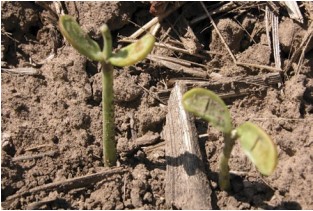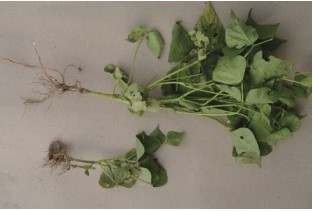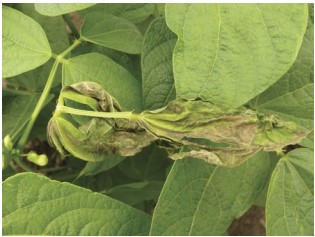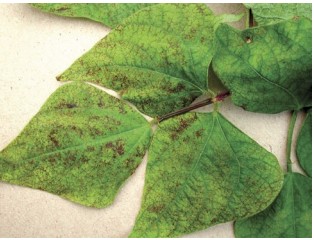Insects and Diseases
Individual descriptions of pests as well as scouting and management strategies can be found on www.DryBeanAgronomy.ca. Recommended treatments to control insects, pests and diseases can be found on the OMAFA Crop Protection Hub.
Frost and Hail Damage
Both frost and hail can be devastating to a bean crop. The extent of early-season frost damage will depend upon where the plants were damaged. If the plant is damaged below the cotyledons, it will not recover. If the growing point is damaged, but the lower stem remains intact, the plant will send out new shoots from the base of the leaves or cotyledons. Wait a few days before replanting to see if these shoots appear.
Dry edible beans have a much more limited ability to recover from hail than soybeans. Determinate plant varieties are less likely to recover than Type II indeterminate types. When evaluating hail damage, check for bruising on the plant stem. Stems damaged during the vegetative stage may not be able to support the weight of pods. In addition, wounds from hail damage serve as entry point for bacterial blight pathogens to infect plants. When the pods are damaged by hail, the seeds or entire pods will often rot.
If frost occurs close to maturity, pods that are yellow to brown in colour are often sufficiently mature to escape damage. Green beans will shrivel, retain their off-green colour and result in increased “pick.” Delaying harvest until the beans dry down sufficiently will help prevent staining and improve separation.
Bald Heads
Bald heads refer to seedlings that emerge with damaged or no growing point. Cotyledons (seed leaves) may or may not be present as seen in photo 1. Plants may develop auxiliary buds at the base of cotyledons but they fail to develop. Without a growing point, plants eventually die. The most common cause of bald heads is mechanical damage to seed or harsh handling. Damage is characterized by cracks in the seed coat. This injury should not be confused with symptoms of seed corn maggots, which will leave the seedlings ragged in appearance. Poor quality seed can also cause seedlings to have broken or cracked cotyledons. Seed with moisture content below 16% is more prone to mechanical damage. Use only high-quality certified seed for planting. Treat seed with a fungicide at planting to protect against seedling disease and handle gently to minimize mechanical damage.

Photo 1. Baldheaded beans lack seed leaves.
Soil Compaction and Soil Structure
Dry edible beans are one of the crops most sensitive to compaction, tillage hard pans or poor soil structure. Often plants become stunted, as seen in Photo 2, because diminished root growth cannot sustain top growth. Restricted or stressed root systems often develop root rot disease. Options to alleviate compaction or improve soil structure during the growing season are limited to inter-row cultivation. This can loosen and aerate the soil and throw loose dirt around the base of the plant to encourage new roots to develop. Foliar fertilization is effective for correcting micronutrient deficiencies, but plants cannot absorb sufficient nitrogen, phosphorous or potassium through foliar application.

Photo 2. Soil compaction in white beans results in shallow root systems as seen in the plant on the bottom.
Bronzing and Sunscald
Bronzing is the result of ozone damage to the leaf surface. A reddish-brown flecking or “bronzing” (shown in photo 3.) occurs on the top leaves of the plant and symptoms vary with length of exposure and weather conditions. Symptoms are more pronounced during moist conditions. Sunscald is caused by intense concentration of the sun’s heat on plant tissue (shown in photo 4.). Sunscald can occur on leaves, stems or pods and most often affects new succulent leaf tissue. Affected leaves can exhibit brown scorched leaf tissue or white discolouration of upper exposed leaves. Leaf tissue becomes necrotic and crumbles easily, resulting in a ragged leaf appearance. Injury often occurs when bright sunny days follow cloudy, warm and humid conditions. Sunscald is not considered to affect yields.

Photo 3. High temperatures can burn top leaves causing wilting or brown necrosis similar to frost injury.
Bronzing is caused by exposure to ozone (O3). Ozone is caused by air pollution and lightening produced during storms. Conditions of intense sunlight or high temperature favour ozone damage. Under dry conditions plants are more tolerant to ozone, therefore symptoms may be more severe under moist conditions. The amount of damage found on the plant, or in an area, often corresponds to air pollution alerts or heavy thunderstorms. Damage appears as brown-reddish discolouration on the upper surface of leaves. Pods may also be affected, but damage is usually superficial, and seeds are typically not affected. Bean cultivars vary in their susceptibility to ozone. Black beans appear to be particularly susceptible.

Photo 4. Bronzing damage affects the upper leaves of dry bean plants and is caused by ozone.